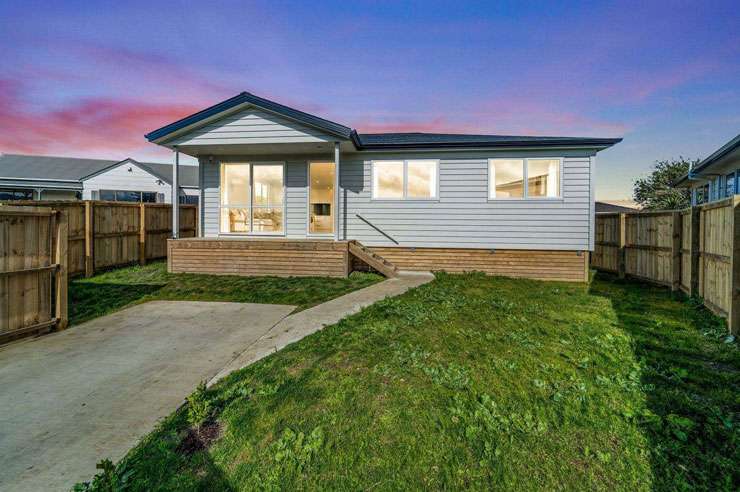First home buyers have traditionally flocked to Massey in West Auckland but the perception the suburb is cheap has created competition which has driven up prices, agents say.
There’s a lot of developer competition for sites with land, too, and a lot of building activity is underway in what is still one of the cheaper Auckland suburbs, though OneRoof data shows the median value is up 33% on last year to $1.022m.
Diego Traglia, a top seller for Harcourts Northwest, says Massey has always been seen as entry level stepping-stone territory for first home buyers, with its close motorway connections and more recent proximity to the Westgate Mall strong drawcards – but it’s no longer that cheap.
“You get a lot of people who go, ‘It might not be our forever home but that is our entry-level home that we can buy with a little bit of land. We can have three bedrooms, we can have a garage as well and we don’t have to spend $1.5m.’
Start your property search
“That’s created a lot of competition. You go back 12 months and you could have bought a three-bedroom, one bathroom for $750,000, $800,000 in Massey.
“Obviously, the prices have gone up considerably but because people’s perception is Massey is entry-level cheap, what you’re finding now is that, actually, the prices are really, really high – sometimes I’m looking at what something in Birkenhead or Beach Haven (on the North Shore) sells for and it ain’t that much more than what properties in Massey are selling for.”
With supermarkets and shopping centres on the doorstep, the American chain Costco coming to neighbouring Westgate, and it taking only 20 minutes to get to the CBD with no traffic, people who buy in Massey soon realise the location is pretty good, he says.

23a Sabot Place, in Massey, West Auckland, is one of three new homes on 929sqm that previously housed just one property. Photo / Supplied
And while prices have risen, you can get more for your money than more expensive suburbs. For example, Traglia has a five-bedroom, two-bathroom house at 241 Royal Road on 921sq m of land listed for $1.379m but the house went under contract as soon as it was passed in at auction.
“A house like that in Mt Albert you’d be looking at $2.5m,” says Traglia.
He has also just listed three new three and four bedroom properties which replaced a single 1970s house on 929sq m at 23 Sabot Place. The houses – 23a, 23b and 23c – are all big but they are on smaller parcels of land than the original house.
Moritz Muck, principal and owner of Harveys Henderson, says Massey is a suburb to watch if you are a first home buyer or a developer because there are still affordable streets and pockets in areas like Reynella Drive and Triangle Road, though there are a few big power pylons around the place which could knock $50,000 or more off prices.
“Here and there you’re going to be stuck under power lines which might not be for everyone but you’ll certainly buy a house a lot cheaper if it is.”
Muck says you can still pick up a two-bedroom brick unit in Massey for around $650,000 and a standalone house on a cross lease for around $800,000.
“You’d get a nice redecorated three-bedroom weatherboard bungalow, probably a Neils home original – Neils built a lot of homes around Massey in the 1980s and 1990s.”
And the suburb still has a lot of land available, particularly around Red Hills Road and the top of Don Buck Drive.

Valocity director of valuations James Wilson says Massey is popular with first home buyers and investors. Photo / Supplied
Muck, who started his career in Massey 17 years ago, says the suburb is pretty standard.
“You’re in the heart of West Auckland. You’re not in Remuera, it’s not Epsom. It’s not a flashy suburb but I think for anyone that’s looking to get into the market it’s definitely a place to look.”
James Wilson, director of valuations at OneRoof’s data partner Valocity, agrees prices in Massey have driven the suburb’s popularity for a long time.
But while first home buyers are dominant, there are submarkets at play, such as stock which has only traditionally transacted among investors.
There has also been plenty of infill building, where the Unitary Plan has allowed for the removal of a single family home and the building of modern townhouses in its place.
“That stock has appealed to first home buyers quite heavily, so they’re now viewing it as a way to get a modern or brand new build in a location close to motorways, good transport, things like that,” he says.
The Government’s changes to the Brightline test saw a drop in the investor share in Massey but not dramatically, Wilson says, and he expects to see competition for the new builds between investors and first home buyers continue.










































































